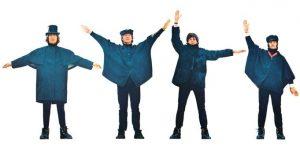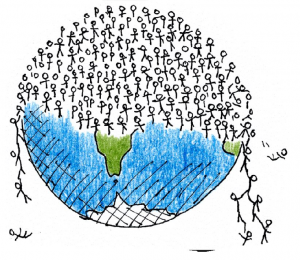A guide to Individual Savings Accounts (ISAs)

 Missing the obvious, and a view from the front line.
Missing the obvious, and a view from the front line.
This is a personal piece which I hope will resonate with our readers whilst influencing all our strategies and thought processes. Many KMG clients were born post war, and, like me, grew up through the 1950s and 60s when nationalisation, collective management, comprehensive schools etc were all the rage.
Children born in the 1970s through to the 90s in the era of flower power, the Beatles, cold wars, three-day working weeks, power cuts (and with hindsight ever-rising living standards) were shaped by a very different set of life-changing events.
Our grandchildren arriving post-Thatcher, post the free market experiment of deregulation, together with 70 years of relative peace, have of course almost unlimited access to resources and information ranging from music to politics, the use of text messages, WhatsApp and the many other forms of communication and social networking we subliminally take for granted, it is these children who are shaping our future with such rapid change.
In my own case (lucky me) the discovery that we are at the very beginning of a new world of medical science is transformational. This means we are all beginning to understand how we process food and what food and exercise mean for our mental state. This knowledge combined with the growing desire to extend longevity whilst not being a drain on the NHS, create the knowledge that can quickly and subliminally change our world faster than we can begin to understand. (Even whilst the headlines scream about a failing NHS, this is not a failing system, but one which is just managing its transformational change). Each and every one of us are making life-style choices to counter these issues and as far as possible avoid unwanted suffering and expense – while living a more fulfilling life. And this is what KMG is helping you to achieve with efficient investment returns.
As an example of phenomenal positive human evolution and tremendous gain, let me share with you just one thing which changes the future right now: through genetic code management, soon, and like me (luck me again) we will all know our genetic code. We will all know how our genes evolve and change through our lives, how they are influenced by climate, stress, diet and of course by our hereditary code. Genetic code management is already shaping our lives beyond our wildest dreams even though we are only just beginning to understand what it means for each of us. (See also Blockchains article in this bulletin).
 As we all know, genes are just a part of the story as are lifestyle choices, even when you live on a dollar a day. As we know, fewer people die in wars, conflict, and murder across the world as each year passes. Absolute poverty continuously falls each year, and more people die from obesity than from famine across the whole world. In general, everyone’s diet has improved, but too many people still eat food which is not good for us (ironically the diet of the post-war generation that was fed to me).
As we all know, genes are just a part of the story as are lifestyle choices, even when you live on a dollar a day. As we know, fewer people die in wars, conflict, and murder across the world as each year passes. Absolute poverty continuously falls each year, and more people die from obesity than from famine across the whole world. In general, everyone’s diet has improved, but too many people still eat food which is not good for us (ironically the diet of the post-war generation that was fed to me).
The great thing for us all is that information is everywhere. It is challenging, frightening, but also exciting. It helps to restrict crazy people, be they Americans, Koreans or dictators but fundamentally as we change our lifestyles and adapt with this information, so our mental capacity not only changes, but clearly improves. As we all become more capable of managing our lives, our health will improve and thus what we need will change so the shape of the future is changing too, and KMG is changing with the revolution.
Recognising, interpreting, embracing and investing in everyone’s future thoughts and aspirations continues into our investment management themes. We believe that because of what we know and because of what we are discovering, the reality is that markets will grow, humans will evolve, and we will all prosper and become wealthier, maybe not materially, but our mental ability to manage our lives will create much wealthier societies across the whole world. What this means for KMG clients are stable, profitable investment solutions which adapt to the changes that are all around us.
We will manage climate change through lifestyle choices and investment strategies, (great investment opportunities are abundant here), and the same will be true for healthcare, housing and every facet of our lives.
KMG starts 2018 with a very positive outlook for the future, embracing and managing the enormous changes before us all. Happy New Year!
Patrick McIntosh
 Are we over populated? Here are some thoughts on the macro overview.
Are we over populated? Here are some thoughts on the macro overview.
The population of the whole world fits into the Grand Canyon. Or, if we housed the whole population in an average-sized EU house (note average), it would just about fill France.
We think the UK is over-developed. Interesting, a recent survey (see article below) showed most people think that more than 50% of the land is developed, yet the figure is actually less than 10%.
The birth rate in the EU is about 1.7 children per family; so on that basis there will be no one left in the EU in not too many generations!
Migration is no help as affluence destroys the birth rate over time, and people moving to colder climates produce less children. Also, life just gets more expensive and more complicated in colder climates, so survival rates decline anyway.
We can’t afford to pay for the promised welfare, so a huge culture-change is in process right now – be it involving birth rates, lifestyles and choices, or the shape of material wealth.
Is productivity slowdown a consequence of poor planning, especially around housing, migration and education? Is infrastructure partially to blame resulting in:
 Are all these issues forcing up inflation and the demand for better education? Growth only comes from ideas.
Are all these issues forcing up inflation and the demand for better education? Growth only comes from ideas.
The average increase in income forever is about 2.3% (real terms excluding inflation), thus incomes double about every 30 years. It has been forever thus.
Remember the constant “inflation is always and everywhere”. It’s just different this time. The fall in unemployment everywhere and increasing global gross domestic product suggests some form of inflation is out there somewhere. Supply equals demand; but is supply (the dramatic development in technology and the barter system we are all aware of) transforms the demand, inflation is no longer simply monetary, but also intellectual and physical For now, and maybe forever onwards, new technologies will change how inflation appears.
In a perfect world we feel the cost of consumption and thus adapt quickly, as is clearly identified in things such as online shopping. As individuals we generally adjust our life to what we can afford even when ‘bribed’ to take on too much debt. In the end we adjust, and as is seen in the private sector (but not yet within government), debt as a percentage of personal wealth is declining.
Corporations over-supply if they can, until reality catches up, because the cost and type of consumption eventually demand change.
Governments rarely feel the cost of consumption initially, until reality catches up.
Demand in the end always determines the outcome.
In the new age and present technological revolution, we are living in a world that is both flat and transparent, and the anomalies of the past may be amplified in both a positive or negative way.
But one thing is not in doubt: we are not over-populated and are unlikely ever to be so. But ware under-educated, and we are running out of humans with relevant skills. Education has always lagged human subliminal ingenuity and thus nothing is different now, it just appears in a different shape. What this means for KMG investment strategies and our holistic approach to your lives is:
Patrick McIntosh
 We often hear the term blockchains, and since our seminars last October discussion on the subject has increased, particularly as we hear about many developments in crypto currencies. Blockchains will, in time, take over as we become confident in transferring value (and not just money) to manage our lives in ways we cannot begin to imagine.
We often hear the term blockchains, and since our seminars last October discussion on the subject has increased, particularly as we hear about many developments in crypto currencies. Blockchains will, in time, take over as we become confident in transferring value (and not just money) to manage our lives in ways we cannot begin to imagine.
Here we will repeat a basic example about the workings of blockchains, using code, as given in our seminar:
Morse code is something we all understand and are taught the principle of at a young age. SOS is dot dot dot – dash dash dash – dot dot dot. The code allows a distress call to be transmitted simply and quickly, and with minimum equipment. Its use started in 1905 and was instantly recognisable to everyone. Computer coding developed from this basic idea, and all computer coding uses dots and dashes, but has been expanded to use hash tags, numerals and other symbols. Breaking the enigma code by Turing in the Second World War was a turning point and showed how difficult even simple coding is to break, and how sophisticated it was even back then.
 So, code has been with us for a long time, and as Turing proved, code can be broken. But the time and effort and power required to break the code is so enormous that long before any criminal has broken the code they will be spotted and thus foiled. Breaking a code is like security at your home: the more you do to put off burglars, the less likely it is that anyone will bother to steal from you.
So, code has been with us for a long time, and as Turing proved, code can be broken. But the time and effort and power required to break the code is so enormous that long before any criminal has broken the code they will be spotted and thus foiled. Breaking a code is like security at your home: the more you do to put off burglars, the less likely it is that anyone will bother to steal from you.
There are two parts to blockchains:
First there must be an identifier code for the item we want to register, and this must be created by something or someone we trust. Take a very simple example: your passport. When you send in a photo to renew your passport it gets coded by the office you trust i.e. government, and your photo gets changed into a series of dots, dashes etc.
 Second, there needs to be a key to open the code which in the passport example is of course your face or eye or finger print, whatever has been encoded.
Second, there needs to be a key to open the code which in the passport example is of course your face or eye or finger print, whatever has been encoded.
So, the only way to open the code is with a ‘key’ recognised by the code. Another example is if you use ApplePay (or any other finger print recognition system). The same principles apply and very soon you will be pay for almost everything by this method, even your basic shopping in the local store!
Sometime soon all your medical records will be encoded to you, so will your bank accounts, car details, house deeds etc. They will be converted to code and owned by you, and can only be opened or transferred to anyone else by you. Your whole account at KMG will, in time, evolve in this way.
Blockchains form the basis of crypto-currencies and are based on a block of currency which has a unique register number and the owner is coded. As you transfer the currency the code is transferred from owner to owner.
 For those who complete their tax returns on line, have you noticed that your state pension or your earned PAYE income is filled in already? This is because government and tax departments are starting to build blocks of knowledge relating to you and are now connecting them together: this is a blockchain. The age of anonymity is coming to an end!
For those who complete their tax returns on line, have you noticed that your state pension or your earned PAYE income is filled in already? This is because government and tax departments are starting to build blocks of knowledge relating to you and are now connecting them together: this is a blockchain. The age of anonymity is coming to an end!
Your life is already surrounded by blockchains. When you use your smart phone, iPad or computer have you noticed the adverts that appear? They happen to be related to something you were looking at recently. The system monitors and tracks your habits to tailor the marketing of goods. The system is getting smarter through the use of blockchains.
Blockchains are as they say, blocks of information connected (chained) together to complete a transaction. This could be ownership of a house or car, banking or individually targeted marketing.
Watch around you, blockchains are not only in the news but a reality all around. Don’t be surprised that KMG lead the way in helping you to move into this exciting and challenging world, both in how we manage your funds and by the speed and ease with which we can administer your affairs. But we do have to for now work in the constraints of more pre-historic systems like banks and cheque payments! Blockchains, ultimately lead to reduced costs thus improving returns, and more importantly reducing exposure to volatility. This leads to peace of mind and greater security for your lives, families and the future.
Patrick and Jenna
Every council area in the UK has been analysed and individual maps produced showing much of the area falls into four land categories:

More than half of the UK land area is farmland (fields, orchards etc), just over a third might be termed natural or semi-natural (moors, heathland, natural grassland etc), a little under 6% is built on (roads, buildings, airports, quarries etc) and 2.5% is green urban (parks, gardens, golf courses, sports pitches etc).
The four categories are drawn from 44 different land use codes used by the Co-ordination of Information on the Environment (Corine) project initiated by the European Commission in 1985.
Using high-definition satellite images and detailed local maps, Corine offers a comprehensive picture of every corner of the United Kingdom. Now that information is readily available to everyone.
The local authorities with the highest proportion of farmland are the Isles of Scilly (96%) and Mid Suffolk (95%). The council area with the greatest quantity of “natural” landscape is Highland (91%). The City of London has the highest amount of land that is built on (98%) and the local authority with the greatest proportion of green urban is Richmond upon Thames (58%).
The data has been produced with the help of Dr Alasdair Rae from the Urban Studies and Planning Department at the University of Sheffield.
Methodology
The largest component of the “built on” category is “discontinuous urban fabric”, within which 20-50% of the surface area may be green space. To account for this we have reassigned the minimum 20% of “discontinuous urban fabric” to “green urban”, which in many cases may be an underestimate. The map uses building land cover data from Ordnance Survey.
Source: BBC